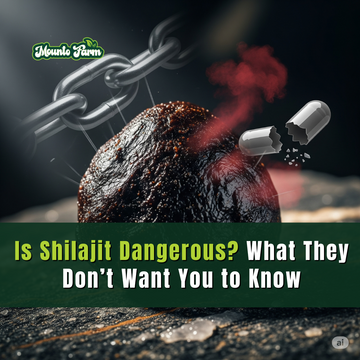
Shilajit is a sticky, tar-like substance found in the Himalayan mountains and used for centuries in Ayurvedic medicine. It's often promoted for boosting energy, improving stamina, and enhancing male fertility. But as its popularity grows, so does the concern about whether it’s truly safe. So, is Shilajit dangerous? Let’s break it down.
What Is Shilajit and How Is It Used?
Shilajit forms over centuries from decomposed plant material and minerals. It contains fulvic acid, humic acid, and over 80 minerals, making it a rich supplement for natural health remedies. It's typically consumed as a resin, capsule, or powder.
Traditionally, Shilajit has been used to support strength, stamina, mental clarity, and immune function. In modern wellness, it’s marketed as an adaptogen and performance enhancer.
Is Shilajit Dangerous? Understanding the Risks
On its own, pure Shilajit is generally safe. However, the danger lies in contamination and improper use.
Many Shilajit products are not purified properly and may contain:
-
Heavy metals like lead, arsenic, and mercury
-
Mycotoxins from mold-contaminated environments
-
Free radicals or harmful residues from poor processing
Additionally, some users report side effects such as:
-
Headaches
-
Dizziness
-
Allergic reactions
-
Increased heart rate
While these side effects are usually mild, they can become serious if Shilajit is contaminated or overused.
Is Shilajit Dangerous for Certain People? Who Should Avoid It?
Yes, some groups should be extra cautious or avoid Shilajit altogether:
-
Pregnant or breastfeeding women: Lack of safety data makes it risky.
-
People with heart conditions or low blood pressure: Shilajit may lower blood pressure further.
-
Those with autoimmune diseases: It may stimulate the immune system and worsen symptoms.
-
Individuals on prescription medications: Especially for diabetes, blood pressure, or thyroid—interactions are possible.
If you're in any of these categories, consult your doctor before considering Shilajit.
Is Shilajit Dangerous When Taken in High Doses?
Overdosing on Shilajit can lead to complications. Like any supplement, more is not always better.
Possible signs of overuse include:
-
Nausea or vomiting
-
Diarrhea
-
Rapid heartbeat
-
Anxiety or restlessness
-
Skin rash or irritation
Long-term overuse of low-quality or untested products can result in heavy metal toxicity, which may damage organs and lead to chronic health issues.
How to Safely Use Shilajit and Avoid Dangers
To minimize risks, follow these safety tips:
-
Choose purified Shilajit: Look for third-party testing and certifications.
-
Start with a small dose: Typically 300–500 mg per day is safe for most adults.
-
Avoid unregulated brands: Especially those without ingredient transparency or lab tests.
-
Consult a professional: Especially if you're on medication or have pre-existing health issues.
Always read the label and avoid combining Shilajit with other stimulants or herbs unless approved by a healthcare provider.
Conclusion
So, is Shilajit dangerous? It can be—if used carelessly or sourced from questionable brands. But when used correctly and in moderation, purified Shilajit is considered safe for most healthy adults.
The key takeaway: purity, proper dosage, and professional guidance matter. Don't cut corners when it comes to your health. With the right product and precautions, Shilajit may offer real benefits—without the danger.
Don’t risk your health with low-quality products. Always choose lab-tested, purified Shilajit from trusted sources.




